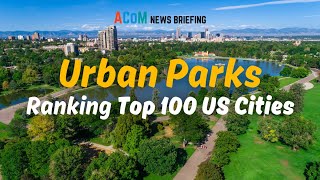Vidya Sethuraman
India Post News Service
Urban parks are more than just places for relaxation or recreation, though those benefits are important. A groundbreaking new poll reveals that parks also serve as essential spaces for connection, where people from diverse backgrounds interact in ways that are increasingly rare in today’s polarized society.
More than half of Americans say they’ve spoken with someone they didn’t know, and who came from a different social or economic background, while visiting a park. The data also show that cities with strong park systems tend to have higher rates of volunteering, more civic organizations per capita, and greater success in developing community leaders.
The briefing on May 23 explored which cities have made the most progress in improving their parks and which still have work to do. Since the COVID-19 pandemic, interest in green spaces has surged, and many cities have increased investments. Yet, despite this momentum, funding remains uncertain, and budget cuts loom. Panelists discussed the latest ParkScore report, highlighted key findings from the poll, outlined strategies that are working, and spotlight the cities leading the way in building more inclusive, impactful park systems.
Will Klein, Director of Parks Research, Trust for Public Land pointed out that the top ten cities in the nation’s park systems this year include Washington, D.C., Irvine, California, Minneapolis and Cincinnati. Among them, Washington has ranked first for five consecutive years, which is attributed to the long-term planning of including park land in the early stages of the city’s construction. Washington, DC, scored well on all ParkScore rating factors. Twenty-one percent of land in the District of Columbia is reserved for parks, among the highest in the United States. The District also outperformed ParkScore’s park access metric. More than 99 percent of District residents live within a 10-minute walk of a park.
Guillermo Rodriguez, California State Director and VP-Pacific Region, Trust for Public Land pointed out that Los Angeles’ park system has fallen from 49th to 90th in the United States in the past five years, reflecting multiple problems such as uneven distribution of resources, long-term lack of planning updates, and insufficient investment. He said that currently about 1.5 million residents in Los Angeles cannot walk to nearby community parks, and the situation is especially serious in low-income and non-white communities. In contrast to other cities’ standards of updating park master plans every five to 10 years, Los Angeles has not updated its park master plans since 1973. Rodriguez pointed out that in addition to chronic underfunding, uneven allocation of resources is also a core problem. According to the survey, the city’s natural reserves and large parks are mostly concentrated in affluent areas such as the WestSide of Los Angeles. However, South Los Angeles and the East Side, which are densely populated and inhabited by ethnic minorities, are severely lacking in green space, forming the so-called “green space inequality.”
Justin Cutler, Commissioner of Parks & Recreation, City of Atlanta shared that the city is working with school districts to promote the “School Playground Opening Plan” to make school playgrounds open to community residents after school, greatly improving residents’ accessibility to parks. He pointed out that starting from 2024, Atlanta’s coverage of parks within a 10-minute walk will increase from 79% to 82%, and the overall ParkScore ranking will also rise from 25th to 21st.
Yvette Lopez-Ledesma, Greening America’s Cities Fellow, Community Partners, a community partnership organization, further explained the progress of the assessment plan. She emphasized that parks are the lifeline of the community. They are not only recreational spaces, but also infrastructure for many social welfare services such as food distribution, childcare, and disaster response. “In communities lacking green space, residents’ life expectancy is shortened by an average of 10 years.”
PARKSCORE METHODOLOGY AND RANKINGS
The annual ParkScore® index ranks park systems in the 100 most populous U.S. cities and is widely considered the gold standard for park evaluation. ParkScore rankings are based equally on five factors:
- Park access measures the percentage of residents living within a 10-minute walk of a park.
- Park equity compares per capita park space and 10-minute-walk park access in communities of color vs. white communities and in low-income neighborhoods versus high-income neighborhoods. Park systems score higher if disparities are minimal or non-existent.
- Park acreage is based on a city’s median park size and the percentage of city area dedicated to parks.
- Park investment measures park spending per resident.
- Park amenities assesses the availability of seven popular park features: basketball hoops; off-leash dog parks; playgrounds; splash pads and other water-play structures; sports fields; recreation and senior centers, and restrooms.
According to Trust for Public Land, the 10 highest-ranking park systems in the United States are:
Rank City ParkScore (Max 100)
- Washington, DC 85.5
- Irvine, CA 84.3
- Minneapolis, MN 83.6
- Cincinnati, OH 82.0
- St. Paul, MN 81.8
- San Francisco, CA 80.2
- Arlington, VA 77.9
- Seattle, WA 77.4
- Portland, OR 76.0
- Denver, CO 75.1








